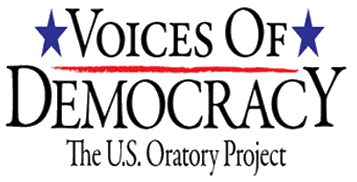FRANCES WATKINS HARPER, “WOMAN’S POLITICAL FUTURE” (20 MAY 1893)
Classroom Activities
1. What beliefs about the state of late nineteenth-century America does Harper express in this speech? What role did men play in creating this state of affairs? What role should women play?
2. Look up the term “feminist” in a contemporary reference book. While the term was not in popular use during her time, would Harper be considered a feminist today? Identify passages from the speech to support your response.
3. Read some of the reactions to Harper’s earlier speeches as recounted in the biographical sketches found in Hallie Quinn Brown’s Homespun Heroines and Other Women of Distinction. New York: Oxford, 1988. 96-103 (or Digital Schomburg African American Women Writers of the 19th Century http://digilib.nypl.org/dynaweb/digs/wwm97253/@Generic__BookView) and in William Steel’s The Underground Rail Road. (Philadelphia: Porter and Coates, 1872), 755-779.
(or The Underground Rail Road at https://www.qu.edu/media/ABL/etext/ugrr/ugrrmain.html). What aspects of her delivery seemed most remarkable to these nineteenth-century audiences? How might the women attending the Columbian Exposition’s Woman’s Congress have responded to Harper?
4. In paragraph 5 of “Woman’s Political Future” Harper mentions a “national education bill.” She is probably referring to the Blair bill sponsored unsuccessfully first in the 1880s by New Hampshire Senator Henry W. Blair to allocate federal funds for education to prevent the use of literacy tests to prevent blacks from registering to vote. Find out all you can about the history of this legislation. Do you think it would have achieved its purpose?
Student Research
1. The digitized version of the Congress proceedings (May Wright Sewall, ed. The World’s Congress of Representative Women, Chicago: Rand, McNally & Company, 1894) from which Harper’s speech was taken are posted at http://nrs.harvard.edu/urn-3:RAD.SCHL:412244 . The book is also available on microfilm in most major libraries. Browse the table of contents and select another speech on women and civil rights. You might select one of the speeches by the five other black women who spoke at the Congress or you may be interested in one of the other speeches in the chapter “The Civil and Political Status of Women” where Harper’s speech is placed. There are speeches on women and religion, women in the arts, women and education. Compare your selection to Harper’s speech from the standpoint of style, content, and assumptions about audience and values. To what extent does the selected speech assert woman’s civil rights?
2. Describe the arrangement and naming of the buildings at the World’s Columbian Exposition. What do they both suggest about how the organizers wanted to represent the United States on this 400th anniversary of Columbus’s arrival? One electronic database to see is The World’s Columbian Exposition: Idea, Experience, Aftermath.
(http://xroads.virginia.edu/~ma96/WCE/legacy.html). See also the bibliography on the last page of this site for additional print and electronic sources.
3. Consider the differences in style and tone of this speech by Harper and Ida Wells’s speech “Southern Horrors” ibiblio.org/pub/docs/books/gutenberg/1/4/9/7/14975/14975-h/14975-h.htm. Given the audience (middle-class white women) and the subjects (mob violence, civil rights, social justice) which speaker do you think had the greater impact on her audience? Might they both have been successful in different ways? Explain.
4. Read Ida Wells’s preface to the co-authored pamphlet, The Reason Why the Colored American Is Not in the World’s Columbian Exposition, titled “To the Seeker after Truth” http://digital.library.upenn.edu/women/wells/exposition/exposition.html#preface. Although Wells planned to publish the entire work in four languages, she was able to publish it in English only, with the preface also translated into French and German. How do Wells’s answer to the title question and her tactics for dissemination of the pamphlet demonstrate her understanding of participatory democracy?
Citizenship Resources
1. List three debates taking place now in public discourse over the violation of civil rights that require the participants to rank values in some kind of hierarchy. Consider, for example, the pro-life, pro-choice debate, the debate over genetically altered foods, or right to privacy vs. national security. How are conflicting values reconciled through hierarchy arguments?
2. You are on the planning committee for an international conference on women’s progress and future prospects at the beginning of the twenty-first century. Suggest five women to give addresses at gatherings of the whole body. Who would give the opening plenary? Who the closing? Defend your choices based on their general appeal, speaking ability and the various interests they represent. The conference theme is “Preserving the Civil Rights of Women.” Then write a paragraph supporting each choice. What five central civil rights issues will you ask the speakers to address? What advice might
you offer the speakers with respect to their linguistic choices, appeals to values, and hierarchy rankings to accommodate their audience of women from around the world?
3. Margaret Windeyer, who responded to “Woman’s Political Future,” was uncomfortable with Harper’s claim that women had higher moral character, unique skills and special means of influence to offer politics, differences not always linked to the vote. (See her full response in Sewall’s collection, following the speech.) Windeyer, arguing from justice rather than expediency, expressed the concern of many suffragists that such arguments ignored the fact that women were being denied a basic civil right, regardless of the contributions their participation would make. These conflicting tactics can be found in contemporary discourse as well. Is there a difference between treating women fairly and treating them equally? Discuss the use of these two positions in debates around women in the military, women in sports, and women in the workplace, for example.
4. At the 1893 Woman’s Congress, topics listed on the program include “dress reform,” “woman suffrage,” “political liberty,” “effects of industrial change on woman’s marriage prospects,” and “the intellectual progress of Colored women.” Conduct research into the main issues women around the world we face today and develop a list of topics you would expect to find on the program of an early twenty-first century Woman’s Congress. Explain your choices.
Last updated May 4, 2016
